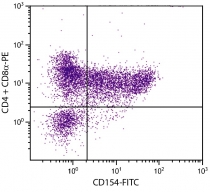ARG62737
anti-CD154 / CD40L antibody [MR-1] (FITC)
anti-CD154 / CD40L antibody [MR-1] (FITC) for Blocking,ELISA,Flow cytometry,IHC-Frozen sections and Mouse
Cell Biology and Cellular Response antibody; Developmental Biology antibody; Immune System antibody
Overview
| Product Description | FITC-conjugated Hamster Monoclonal antibody [MR-1] recognizes CD154 / CD40L |
|---|---|
| Tested Reactivity | Ms |
| Tested Application | BL, ELISA, FACS, IHC-Fr |
| Host | Hamster |
| Clonality | Monoclonal |
| Clone | MR-1 |
| Isotype | IgG3 |
| Target Name | CD154 / CD40L |
| Antigen Species | Mouse |
| Immunogen | Activated mouse Th1 clone D1.6 |
| Conjugation | FITC |
| Alternate Names | TNFSF5; IMD3; T-cell antigen Gp39; HIGM1; CD40-L; gp39; CD40 ligand; Tumor necrosis factor ligand superfamily member 5; CD40L; CD154; TRAP; CD antigen CD154; hCD40L; IGM; T-BAM; TNF-related activation protein |
Application Instructions
| Application Suggestion |
|
||||||||||
|---|---|---|---|---|---|---|---|---|---|---|---|
| Application Note | * The dilutions indicate recommended starting dilutions and the optimal dilutions or concentrations should be determined by the scientist. |
Properties
| Form | Liquid |
|---|---|
| Buffer | PBS and 0.1% Sodium azide. |
| Preservative | 0.1% Sodium azide |
| Concentration | 0.5 mg/ml |
| Storage Instruction | Aliquot and store in the dark at 2-8°C. Keep protected from prolonged exposure to light. Avoid repeated freeze/thaw cycles. Suggest spin the vial prior to opening. The antibody solution should be gently mixed before use. |
| Note | For laboratory research only, not for drug, diagnostic or other use. |
Bioinformation
| Database Links | |
|---|---|
| Gene Symbol | Cd40lg |
| Gene Full Name | CD40 ligand |
| Background | CD154 / CD40L (CD40 ligand) is a member of the tumor necrosis factor family, and is expressed primarily on activated CD4+ lymphocytes, but also on mast cells, basophils, eosinophils and human dendritic cells. Its counter-receptor CD40 is expressed on antigen presenting cells, including dendritic cells, macrophages, and B cells, and also on fibroblasts. Triggering of CD40 by CD40L causes maturation of dendritic cells and upregulation of antigen presentation in functions of the MHC and costimulatory molecules. CD40L also functions as a direct stimulating factor for T cells. CD40L plays also roles e.g. in antibody class switching and modulation of apoptosis in the germinal center. |
| Function | Cytokine that binds to TNFRSF5. Mediates B-cell proliferation in the absence of co-stimulus as well as IgE production in the presence of IL-4. Involved in immunoglobulin class switching (By similarity). [UniProt] |
| Research Area | Cell Biology and Cellular Response antibody; Developmental Biology antibody; Immune System antibody |
| Calculated MW | 29 kDa |
| PTM | The soluble form derives from the membrane form by proteolytic processing. N-linked glycan is a mixture of high mannose and complex type. Glycan structure does not influence binding affinity to CD40. Not O-glycosylated. |
Images (1) Click the Picture to Zoom In
Clone References








